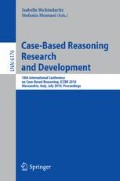Abstract
How to reuse or adapt past solutions to new problems is one of the least understood problems in case-based reasoning. In this paper we will focus on the problem of how to combine solutions coming from multiple cases in search-based approaches to reuse. For that purpose, we introduce the notion of amalgam. Assuming the solution space can be characterized as a generalization space, an amalgam of two solutions is a third solution which combines as much as possible from the original two solutions. In the paper we define amalgam as a formal operation over terms in a generalization space, and we discuss how amalgams may be applied in search-based reuse techniques to combine case solutions.
Access this chapter
Tax calculation will be finalised at checkout
Purchases are for personal use only
Preview
Unable to display preview. Download preview PDF.
References
Bergmann, R., Wilke, W.: Building and refining abstract planning cases by change of representation language. Journal of Artificial Intelligence Research (JAIR) 3, 53–118 (1995)
Carpenter, B.: Typed feature structures: an extension of first-order terms. In: Saraswat, V., Ueda, K. (eds.) Proceedings of the International Symposium on Logic Programming, San Diego, pp. 187–201 (1991)
Cojan, J., Lieber, J.: Belief merging-based case combination. In: McGinty, L., Wilson, D.C. (eds.) ICCBR 2009. LNCS (LNAI), vol. 5650, pp. 105–119. Springer, Heidelberg (2009)
Hanks, S., Weld, D.S.: A domain-independent algorithm for plan adaptation. J. Artificial Intelligence Research 2(1), 319–360 (1994)
Jackendoff, R.: Foundations of Language: Brain, Meaning, Grammar, Evolution. Oxford University Press, Oxford (2002), http://www.isrl.uiuc.edu/~amag/langev/paper/jackendoff02.html
Kay, M.: Functional unification grammar: a formalism for machine translation. In: Proc. 10th Int. Conf. on Computational Linguistics, pp. 75–78. Association for Computational Linguistics, Morristown (1984)
Konieczny, S., Lang, J., Marquis, P.: Da2 merging operators. Artificial Intelligence 157(1-2), 49–79 (2004)
Lavrač, N., Džeroski, S.: Inductive Logic Programming. In: Techniques and Applications. Ellis Horwood (1994)
Mántaras, R.L.D., McSherry, D., Bridge, D., Leake, D., Smyth, B., Craw, S., Faltings, B., Maher, M.L., Cox, M.T., Forbus, K., Keane, M., Aamodt, A., Watson, I.: Retrieval, reuse, revision and retention in case-based reasoning. Knowl. Eng. Rev. 20(3), 215–240 (2005)
Muñoz-Ávila, H., Cox, M.: Case-based plan adaptation: An analysis and review. IEEE Intelligent Systems 23, 75–81 (2007)
Ontañón, S., Plaza, E.: On similarity measures based on a refinement lattice. In: McGinty, L., Wilson, D.C. (eds.) ICCBR 2009. LNCS (LNAI), vol. 5650, pp. 240–255. Springer, Heidelberg (2009)
Ram, A., Francis, A.: Multi-plan retrieval and adaptation in an experience-based agent. In: Leake, D.B. (ed.) Case-Based Reasoning: Experiences, Lessons, and Future Directions. AAAI Press, Menlo Park (1996)
Smyth, B., Keane, M.T.: Adaptation-guided retrieval: questioning the similarity assumption in reasoning. Artificial Intelligence 102, 249–293 (1998)
Steels, L., Beule, J.D.: Unify and merge in fluid construction grammar. In: Vogt, P., Sugita, Y., Tuci, E., Nehaniv, C.L. (eds.) EELC 2006. LNCS (LNAI), vol. 4211, pp. 197–223. Springer, Heidelberg (2006)
Wilke, W., Bergmann, R.: Techniques and knowledge used for adaptation during case-based problem solving. In: 11th International Conference on Industrial and Engineering Applications of Artificial Intelligence and Expert Systems, IEA 1998, pp. 497–506. Springer, Heidelberg (1998)
Wilke, W., Smyth, B., Cunningham, P.: Using configuration techniques for adaptation. In: Lenz, M., Bartsch-Spörl, B., Burkhard, H.-D., Wess, S. (eds.) Case-Based Reasoning Technology. LNCS (LNAI), vol. 1400, pp. 139–168. Springer, Heidelberg (1998)
Author information
Authors and Affiliations
Editor information
Editors and Affiliations
Rights and permissions
Copyright information
© 2010 Springer-Verlag Berlin Heidelberg
About this paper
Cite this paper
Ontañón, S., Plaza, E. (2010). Amalgams: A Formal Approach for Combining Multiple Case Solutions. In: Bichindaritz, I., Montani, S. (eds) Case-Based Reasoning. Research and Development. ICCBR 2010. Lecture Notes in Computer Science(), vol 6176. Springer, Berlin, Heidelberg. https://doi.org/10.1007/978-3-642-14274-1_20
Download citation
DOI: https://doi.org/10.1007/978-3-642-14274-1_20
Publisher Name: Springer, Berlin, Heidelberg
Print ISBN: 978-3-642-14273-4
Online ISBN: 978-3-642-14274-1
eBook Packages: Computer ScienceComputer Science (R0)

